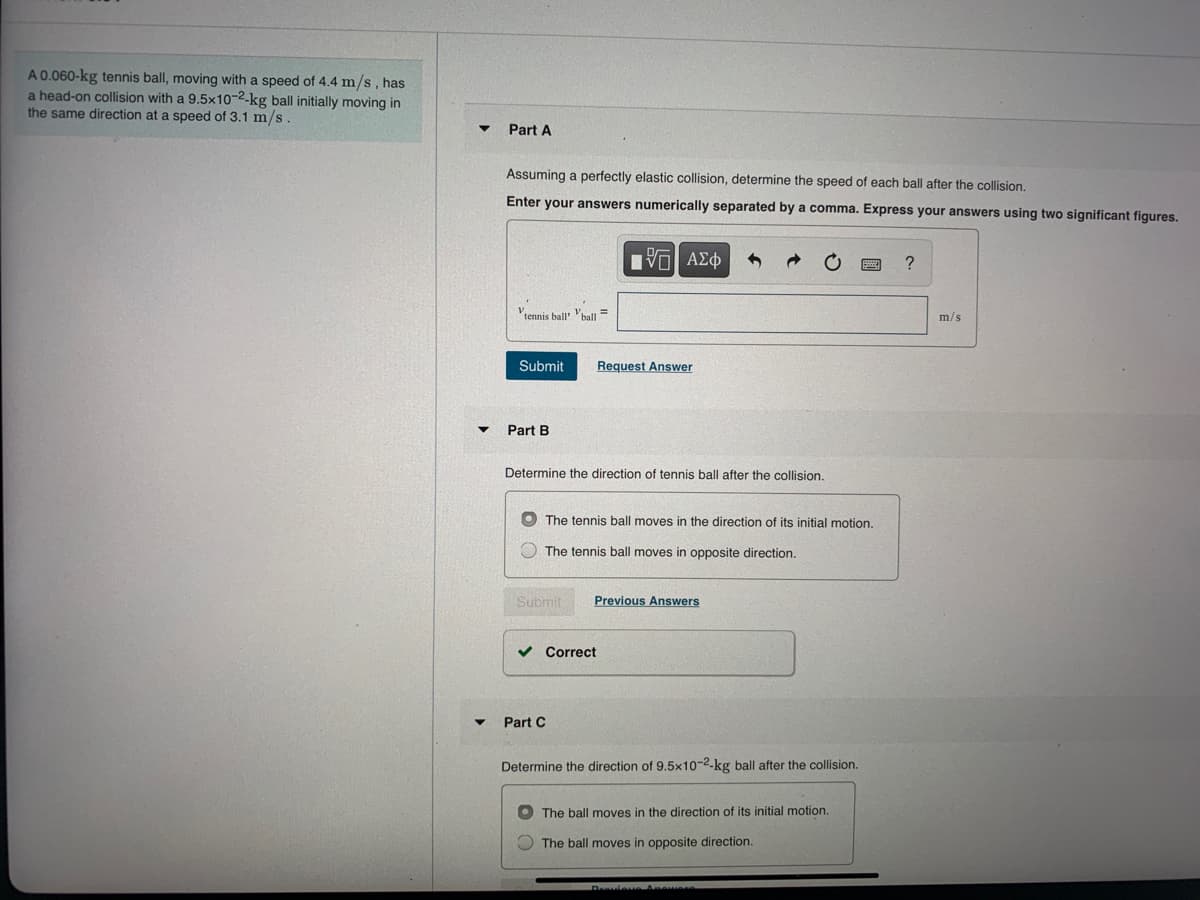A 0.060-kg tennis ball, moving with a speed of 4.4 m/s , has a head-on collision with a 9.5x10-2-kg ball initially moving in the same direction at a speed of 3.1 m/s Part A Assuming a perfectly elastic collision, determine the speed of each ball after the collision. Enter your answers numerically separated by a comma. Express your answers using two significant figures. |ν ΑΣφ ? Vtennis ball 'bal = m/s Submit Request Answer
A 0.060-kg tennis ball, moving with a speed of 4.4 m/s , has a head-on collision with a 9.5x10-2-kg ball initially moving in the same direction at a speed of 3.1 m/s Part A Assuming a perfectly elastic collision, determine the speed of each ball after the collision. Enter your answers numerically separated by a comma. Express your answers using two significant figures. |ν ΑΣφ ? Vtennis ball 'bal = m/s Submit Request Answer
Physics for Scientists and Engineers with Modern Physics
10th Edition
ISBN:9781337553292
Author:Raymond A. Serway, John W. Jewett
Publisher:Raymond A. Serway, John W. Jewett
Chapter9: Linear Momentum And Collisions
Section: Chapter Questions
Problem 17P: A tennis ball of mass 57.0 g is held just above a basketball of mass 500 g as shown in Figure P9.17....
Related questions
Question

Transcribed Image Text:A 0.060-kg tennis ball, moving with a speed of 4.4 m/s, has
a head-on collision with a 9.5x10-2-kg ball initially moving in
the same direction at a speed of 3.1 m/s.
Part A
Assuming a perfectly elastic collision, determine the speed of each ball after the collision.
Enter your answers numerically separated by a comma. Express your answers using two significant figures.
?
tennis ball' 'bal =
m/s
Submit
Request Answer
Part B
Determine the direction of tennis ball after the collision.
O The tennis ball moves in the direction of its initial motion.
O The tennis ball moves in opposite direction.
Submit
Previous Answers
v Correct
Part C
Determine the direction of 9.5x10-2-kg ball after the collision.
The ball moves in the direction of its initial motion.
The ball moves in opposite direction.
DrevieueAnewere
Expert Solution
This question has been solved!
Explore an expertly crafted, step-by-step solution for a thorough understanding of key concepts.
This is a popular solution!
Trending now
This is a popular solution!
Step by step
Solved in 2 steps

Knowledge Booster
Learn more about
Need a deep-dive on the concept behind this application? Look no further. Learn more about this topic, physics and related others by exploring similar questions and additional content below.Recommended textbooks for you

Physics for Scientists and Engineers with Modern …
Physics
ISBN:
9781337553292
Author:
Raymond A. Serway, John W. Jewett
Publisher:
Cengage Learning

Physics for Scientists and Engineers
Physics
ISBN:
9781337553278
Author:
Raymond A. Serway, John W. Jewett
Publisher:
Cengage Learning

College Physics
Physics
ISBN:
9781285737027
Author:
Raymond A. Serway, Chris Vuille
Publisher:
Cengage Learning

Physics for Scientists and Engineers with Modern …
Physics
ISBN:
9781337553292
Author:
Raymond A. Serway, John W. Jewett
Publisher:
Cengage Learning

Physics for Scientists and Engineers
Physics
ISBN:
9781337553278
Author:
Raymond A. Serway, John W. Jewett
Publisher:
Cengage Learning

College Physics
Physics
ISBN:
9781285737027
Author:
Raymond A. Serway, Chris Vuille
Publisher:
Cengage Learning

College Physics
Physics
ISBN:
9781305952300
Author:
Raymond A. Serway, Chris Vuille
Publisher:
Cengage Learning

Physics for Scientists and Engineers, Technology …
Physics
ISBN:
9781305116399
Author:
Raymond A. Serway, John W. Jewett
Publisher:
Cengage Learning

Principles of Physics: A Calculus-Based Text
Physics
ISBN:
9781133104261
Author:
Raymond A. Serway, John W. Jewett
Publisher:
Cengage Learning